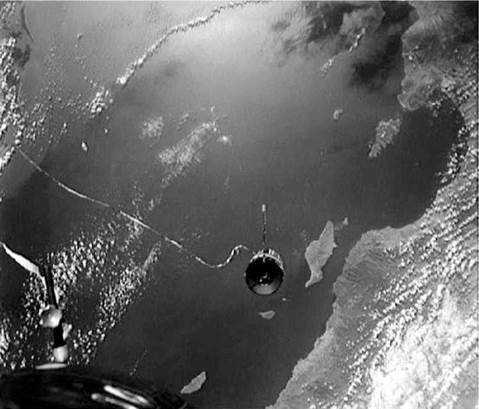The first tentative steps
What followed was a series of one-person flights that pushed the boundaries of human space flight endeavor from a few minutes to up to a few days in the next two years. It was a rapid advancement. The four U. S. Mercury orbital missions during 1962 and 1963 increased U. S. durations from 4 hours to 8, then 22 hours. A planned three-day Mercury mission was canceled, as the agency wanted to move to the more advanced two-man Gemini missions in preparation for the Apollo series.
In 1962, and again in 1963, the Soviets flew two dual flights, increasing their mission durations to between 3 and 5 days and once again stealing the headlines by flying the first female space explorer, Valentina Tereshkova, in June 1963 (Vostok 6) and the longest solo space flight (5 days), by Valeri Bykovsky. The one-person Vostok was then modified to carry additional crew members (all without spacesuits). It reappeared as Voskhod 1 in October 1964, flying a three – person crew (a pilot, doctor, and scientist), before the two-person Voskhod 2 in
 MtriCUN*
MtriCUN*
poiio
Comparing the pioneering American manned spacecraft.
March 1965 during which Alexei Leonov performed the world’s first space walk. These missions were politically motivated, inserted as “space spectaculars” designed to upstage the American Gemini flights, as well as filling time until the more advanced three-person Soyuz was ready. The Voskhod flights were very risky and achieved very little apart from Leonov’s space walk. They diverted resources away from the Soyuz program, the real Soviet competition to Gemini and Apollo.
The multi-purpose Soyuz was designed to perform a variety of tasks for the Soviets. These included rendezvous and docking missions, as a space station crew ferry, as a solo scientific research platform, some with clearly military objectives and, in its guise as Zond, as a two-person lunar transport craft with separate one – person lunar lander. Developed by the OKB-1 design bureau under the powerful leadership of Chief Designer Sergei Korolev, the driving force of the Soviet space program since its inception, Soyuz was hoped to be the salvation of the Soviet effort in space, trying to capture the headlines from the Americans. Unfortunately, the program was plagued with problems from the start. In January 1966 Korolev died on the operating table during surgery and with his loss came a power struggle
|
Gaining the experience—Gemini Agena rendezvous. |
not only at OKB but with other design bureaus for government-supported space programs. Then in April 1967 Cosmonaut Vladimir Komarov was lost in a landing accident on Soyuz 1, and over the next few years difficulties in man-rating the lunar launch vehicle the N1 saw the Soviets abandon reaching the Moon in favor of the creation of large space stations. They issued statements to the effect that the Moon was never actually a target for their cosmonauts at all, which is now known not to be the case. It was a difficult time for the Soviet program.
The Americans, on the other hand, were very successful with their second – generation spacecraft, Gemini. Between March 1965 and November 1966, 10 two-man missions were flown with remarkable consistency. Gemini was planned as a stepping stone between the one-man Mercury and three-man Apollo and was designed to extend the experience of American missions from 1 to 14 days, which was the expected average duration of the Apollo lunar missions. Another objective of Gemini was to perfect the skills of rendezvous and docking and close quarters formation flying, known as Proximity Operations, or “Prox-Ops”. The program also provided the opportunity to conduct far more extensive space walks than had been possible on Voskhod. Incorporating a crew compartment hatch that could be opened in space allowed one astronaut on each of Gemini flights 4, 9, 10, 11, and 12 to conduct pioneering American EVAs. Gemini also afforded the opportunity to fly a number of small experiments and conduct scientific observations on its longer missions and also to perfect the techniques of precision splashdown. On the whole, NASA gained a significant amount of experience with Gemini, taking the long-duration record from the Soviets, increasing their EVA experience, and perfecting docking with unmanned targets. These were important skills to be mastered in advance of the Apollo series of missions and beyond. Indeed, the experience gained during Gemini makes it one of the most important, if still most overlooked, programs in human space flight history.











